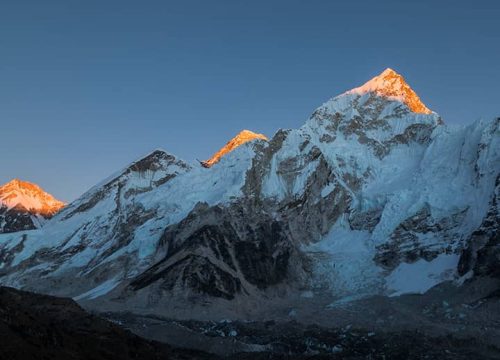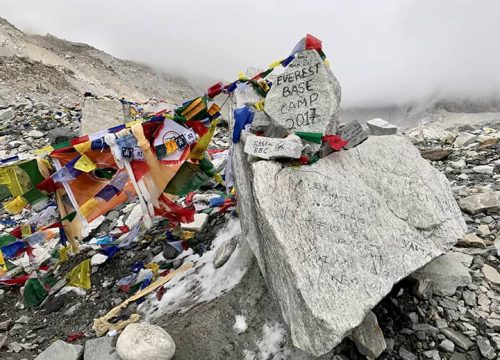Mera Peak Climbing in Nepal: A Complete Guide
Mountain Ascend Treks warmly welcomes you to one of the most thrilling adventures in the Himalayas. This comprehensive guide covers all aspects of Mera Peak Climbing in Nepal, including highlights, training, emergency protocols, packing essentials, itinerary, food, accommodation, permits, costs, and the best seasons to climb.
Climbing Mera Peak, a 6,476-meter high Himalayan summit, provides breathtaking panoramic views of the world’s highest peaks. The trek combines adventure with moderate technical climbing, making it perfect for both aspiring mountaineers and experienced trekkers. Our guided tour lasts 21 days, with 16 days of trekking and climbing, including two summit days. If you are also interested in other Himalayan adventures, check out our Everest Base Camp Trek or Annapurna Base Camp Trek for similar experiences.
Why Mera Peak is Popular
Nepal is home to eight of the world’s ten tallest mountains, making it a top destination for trekking and climbing enthusiasts. Mera Peak Climbing in Nepal may not be extremely technical, but the altitude and challenging terrain make it a rewarding adventure. Every year, thousands of visitors choose this trek to experience the Himalayas’ grandeur and unique cultural landscapes. To explore lesser-known trekking trails, you can also visit our off the beaten path trekking options.
Mera Peak Climbing Highlights
- One of Nepal’s most enticing 6,000-meter trekking peaks.
- Panoramic views of five of the world’s six highest mountains.
- Culturally rich trek through hidden villages and scenic landscapes.
- Well-equipped Base and High Camps for climbers.
- Summit attempt follows a carefully designed acclimatization program.
- Experience guided climbs with our licensed and experienced local guides.
For cultural insights and Nepalese trekking regulations, you can visit the Nepal Tourism Board.
Training for Mera Peak
Start your preparation at least six weeks before your trip. Focus on building stamina, leg strength, and cardiovascular fitness. Hiking with a 10 kg backpack simulates trekking conditions. Gym exercises like step machines, core workouts, Pilates, and aerobic activities help improve balance and strength. Prior experience with winter walking or mountaineering gear is useful, though our guides provide on-site training for rope techniques and safe climbing practices.
Emergency & Evacuation
While Mera Peak is near Lukla, which has hospitals and an airport, evacuation depends on weather conditions. Helicopters may be used in emergencies. Your climbing team ensures safety, guiding you to the nearest secure location for assistance. Renting a horse is an option (approx. $150/day), and helicopter evacuations can be arranged through your insurance provider.
Packing & Kit List for Mera Peak Climbing
Mountain Ascend Treks provides advice on gear and clothing for comfort and safety in varying weather conditions. Porters carry most equipment except your daypack. Essential items include sleeping bags, jackets, thermal layers, trekking pants, hiking boots, gloves, sunscreen, and first aid kits.
For a detailed packing guide, visit our Mera Peak Gear Guide.
Mera Peak Itinerary (21 Days)
- Arrival in Kathmandu (1,400m)
- Sightseeing Kathmandu & Bhaktapur
- Fly to Lukla (2,804m), trek to Chutok (2,800m)
- Trek to Khartitang via Zatrawala Pass (4,704m)
- Trek to Kothey (3,600m)
- Trek to Tangnang (4,356m)
- Acclimatization
- Trek to Khare (5,045m)
- Acclimatization at Khare
- Trek to Mera La (5,415m) & Base Camp (5,300m)
- Trek to High Camp (5,800m)
- Summit Mera Peak (6,654m) & return to Khare
- Reserve/Contingency Day
14–17. Descent to Lukla with stops at Khothey, Zatrabok, Chutenga - Fly to Kathmandu, farewell dinner
- Departure
Meals & Accommodation
In Kathmandu, stay in standard hotels; in the mountains, lodges provide twin beds and heated dining halls. Meals include Nepalese, Tibetan, Italian, Thai, and Chinese cuisines. During trekking, breakfast, lunch, and dinner (with tea/coffee) are provided. Sample Dal Bhat, momo, soups, pasta, and other local delicacies.
Best Season for Mera Peak
- Spring (March–May): Blooming flowers, lush valleys, snow-capped peaks.
- Autumn (September–November): Clear skies, excellent visibility, and moderate temperatures.
Avoid monsoon (June–August) and winter (December–February) due to heavy rain, snow, and cold conditions.
Mera Peak Permits & Costs
Climbing Mera Peak requires:
- Mera Peak Climbing Permit: $250 (spring), $125 (autumn), $70 (off-season)
- Khumbu Rural Municipality Entrance Permit: NPR 2,000
- Makalu Barun National Park Entry Permit: NPR 3,000 ($1,500 for SAARC citizens)
All permits are arranged by your licensed trekking company.
Why Choose Mountain Ascend Treks
With Mountain Ascend Treks, your Mera Peak adventure is safe, organized, and unforgettable. Our experienced local guides, carefully designed itinerary, and full support ensure you enjoy every moment of Mera Peak Climbing in Nepal.





